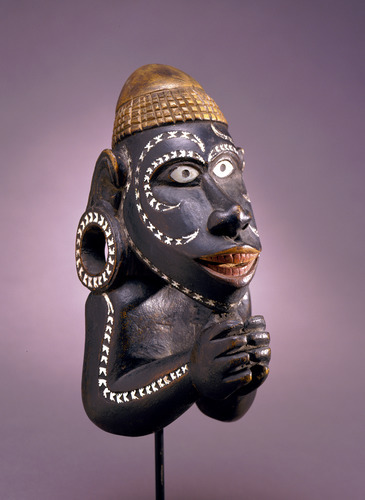Photo

Water Ewer for Rituals (Kundika) with Incised Parrot Design, 1100s, Cleveland Museum of Art: Korean Art
The kundika (water ewer) is a container for holy water that was used for many centuries in Buddhist rituals throughout Asia. In Korea, celadon kundikas were made to mimic the shape and design of metal ones. These metal prototypes feature the theme of birds and willows on their surfaces, whereas celadon kundikas show more simplified motifs. This kundika depicts an engraved bird. Because of its long chin, Korean scholars assign the bird to a parrot design. Size: Overall: 35.3 cm (13 7/8 in.) Medium: stoneware with celadon glaze, incised and carved decoration
https://clevelandart.org/art/1921.631
10 notes
·
View notes
Photo

Effigy Pot, Unidentified Yungur artist, c.1925–50, Saint Louis Art Museum: Arts of Africa, Oceania, and the Americas
https://www.slam.org/collection/objects/44543/
13 notes
·
View notes
Photo

Burial Urn with Stamped Design, 500s-600s, Cleveland Museum of Art: Korean Art
Size: Overall: 8.1 cm (3 3/16 in.); Body: 4.4 x 10.7 cm (1 ¾ x 4 3/16 in.) Medium: stoneware with stamped designs under olive-green glaze
https://clevelandart.org/art/1928.178
23 notes
·
View notes
Photo

Water Ewer for Rituals (Kundika) with Incised Parrot Design, 1100s, Cleveland Museum of Art: Korean Art
The kundika (water ewer) is a container for holy water that was used for many centuries in Buddhist rituals throughout Asia. In Korea, celadon kundikas were made to mimic the shape and design of metal ones. These metal prototypes feature the theme of birds and willows on their surfaces, whereas celadon kundikas show more simplified motifs. This kundika depicts an engraved bird. Because of its long chin, Korean scholars assign the bird to a parrot design. Size: Overall: 35.3 cm (13 7/8 in.) Medium: stoneware with celadon glaze, incised and carved decoration
https://clevelandart.org/art/1921.631
4 notes
·
View notes
Photo

Fikellura Amphora
East Greek, ca. 525 B.C.
Ceramic
Princeton University Art Museum
1K notes
·
View notes
Photo

Bottle with a Flattened Side, 700s-800s, Cleveland Museum of Art: Korean Art
Size: Overall: 25.1 cm (9 7/8 in.); Diameter: 15.9 cm (6 ¼ in.) Medium: stoneware with incised designs
https://clevelandart.org/art/1999.92
15 notes
·
View notes
Photo

Bottle with Incised and Sgraffito Fish Design, 1400s-1500s, Cleveland Museum of Art: Korean Art
This whimsical bottle is classified as Buncheong 분청 (literally, powdered green). Flourishing during the 1400s–1500s, Buncheong indicates pottery with iron-rich clay decorated with white slip. After firing, the color of the clay body usually became greenish-gray due to its high iron content. Korean artists tried to emulate the white porcelain wares of the Chinese Ming period, although the result was not the same. On the surface coated with white slip, the image of a smiling fish is carved in bold lines, a technique distinctive to Jeolla province, a southwest region of the Korean peninsula. Size: Outer diameter: 17 cm (6 11/16 in.); Overall: 30.6 cm (12 1/16 in.) Medium: stoneware with incised design (Buncheong ware)
https://clevelandart.org/art/1962.153
12 notes
·
View notes
Photo

Jar with Horn-shaped Handles, 200s-400s, Cleveland Museum of Art: Korean Art
Size: Overall: 23.5 cm (9 ¼ in.); Diameter of mouth: 15.9 cm (6 ¼ in.); Diameter with handles: 16.5 cm (6 ½ in.) Medium: earthenware with incised decoration and color
https://clevelandart.org/art/1991.137
12 notes
·
View notes
Photo

Jar, 1700s, Cleveland Museum of Art: Korean Art
Austere, pure, and simple are adjectives often associated with white porcelain ware of the Joseon dynasty. Unlike perfectly symmetrical and intricately adorned Chinese or Japanese ceramic pieces, an undecorated Korean white porcelain jar was highly celebrated, particularly among Japanese art historians and connoisseurs. For them, its empty white surface expresses the concept of “not acting or not desiring”—the highest level of self-cultivation. While white porcelain vases taller than 40 centimeters were exclusively for the royal household, relatively small ones, such as this jar, were for court officials and aristocrats. In the scholar’s elegant study, a round white jar often held a branch of plum or peony blossoms. Medium: glazed porcelain
https://clevelandart.org/art/1983.28
11 notes
·
View notes
Photo

Flower-shaped Mirror, 1100s-1200s, Cleveland Museum of Art: Korean Art
Size: Overall: 9.2 x 0.6 cm (3 5/8 x ¼ in.) Medium: bronze
https://clevelandart.org/art/1917.678
7 notes
·
View notes
Photo

Storage Jar with Loop Handles, 200s-300s, Cleveland Museum of Art: Korean Art
Size: Diameter: 34.3 cm (13 ½ in.); Overall: 32.1 cm (12 5/8 in.) Medium: earthenware with impressed adn incised designs
https://clevelandart.org/art/1989.475
11 notes
·
View notes
Photo

Burial Urn with Cover, 300s-500s, Cleveland Museum of Art: Korean Art
Size: Overall: 55.8 cm (21 15/16 in.); Outer diameter: 43 cm (16 15/16 in.) Medium: earthenware with impressed design
https://clevelandart.org/art/1990.131
14 notes
·
View notes
Photo

Terracotta lekythos (oil flask) by Sappho Painter, Metropolitan Museum of Art: Greek and Roman Art
Rogers Fund, 1941 Metropolitan Museum of Art, New York, NY Medium: Terracotta
http://www.metmuseum.org/art/collection/search/254201
42 notes
·
View notes
Photo

Burial Urn with Stamped Design, 500s-600s, Cleveland Museum of Art: Korean Art
Size: Overall: 8.1 cm (3 3/16 in.); Body: 4.4 x 10.7 cm (1 ¾ x 4 3/16 in.) Medium: stoneware with stamped designs under olive-green glaze
https://clevelandart.org/art/1928.178
10 notes
·
View notes
Photo

Steatite vase with spout and lugs, Metropolitan Museum of Art: Greek and Roman Art
Bequest of Richard B. Seager, 1926 Metropolitan Museum of Art, New York, NY Medium: Steatite
http://www.metmuseum.org/art/collection/search/252351
9 notes
·
View notes
Photo

Canoe Prow Figurehead (nguzunguzu or toto isu), probably central Solomon Islands, probably late 19th to early 20th century, Saint Louis Art Museum: Arts of Africa, Oceania, and the Americas
https://www.slam.org/collection/objects/40201/
119 notes
·
View notes
Photo

Tea bowl by Shoji Hamada, circa 1965.
via TATE museum.
10 notes
·
View notes